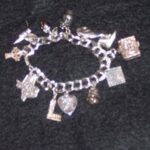Charm bracelets are jewelry worn around the wrist and hold charms that represent important events in ones life.
Since prehistoric times man has made charm bracelets, or often called amulets or talisman. Rocks, clay, bones, wood and shells were often used when creating a bracelet. Wearing a charm bracelet was often associated with spirituality, love, magic and protection. Early charms were made from lapis lazuli, rock crystal and other stones
More elaborate bracelets with precious stones and metals emerged during the Egyptian Pharaoh age. As early as 3000 BC Egyptians were using charms to ward off evil spirits, increase fertility rates, protect their loved ones in the after life and guarantee wealth. They were also a way for the Gods to be able to identify the wearer of the charm bracelet, so they were placed in the correct social level.
The Assyrians, Persians and Babylonians also created and wore charm bracelets.
During the Roman Empire era, Christians woulds identify themselves, to gain access into secret worship activities, by revealing the fish charm hidden under their clothing.
Charm bracelets gained popularity in the mid 1800s when Queen Victoria wore small lockets holding family portraits and a lock of hair from Prince Albert, her husband.
After World War II, American soldiers came home with charms as gifts, that were handmade by the locals were the soldiers were stationed. Charm bracelet popularity was reaching new heights by this time.
During the 1950s a must have accessory for girls and women, was a charm bracelet. Traditionally a woman received a charm bracelet twice, as a young girl and at her marriage. These bracelets would have charms that show her hobbies, religion and interests as a girl and wedding bells for marriage, latter charms for births and anniversaries would be added.
In the 1970s charms made of celluloid were prizes in gum-ball machines. Kids collected these charms for their charm bracelets. Charms ranged from army men themes, sports and animals to Betty Boop, Orphan Annie and Mickey Mouse. They faded out in the early 1970s but came back again the the mid 1980s.
Buyers were picking up charms in antique stores and flea markets, that had been out of circulation for decades, for very cheap prices. A high demand for vintage charms and charm bracelets began in the 1990s. Charms with moving parts often sold for over $100 dollars and a $10 dollar gold charm purchased in 1950 was easily selling for $70, $80 dollars and more.
In 2001 the fashion industries once again introduced the charm bracelet. Soon new charms in all price ranges were all over the market. Italian charm bracelets were big during this time. Rather than having charms that dangles off the bracelet, these charms snapped flat onto the bracelet.
Since 2002 a new trend emerged in Europe and North America, for European charm bracelets. These are bracelets made from gold, silver or murona glass and have chains for attaching the charms. Some beads used are beads that were used were also of gold and silver as well as diamond.
sources:
rembrandtcharms.com
wikipedia online


